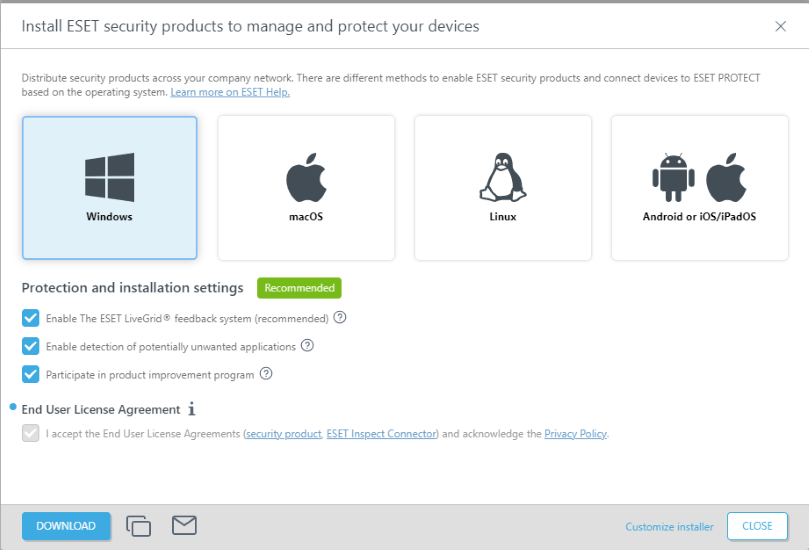Installers
This section shows you how to create Agent installer packages to deploy ESET Management Agent on client computers. The installer packages are saved in ESET PROTECT Web Console, and you can download, distribute via email or link them again when necessary.
Click ![]() Installers > Create Installer and select the operating system.
Installers > Create Installer and select the operating system.
Select the installer settings, accept the EULA and select one of the installer distribution options (installer settings and distribution options may vary based on the operating system):
•Click Download to download the installer package.
•Click the ![]() Copy icon to copy the installer's link to your clipboard.
Copy icon to copy the installer's link to your clipboard.
•Click ![]() Email icon to send an email with a link to the installer package.
Email icon to send an email with a link to the installer package.
Or click Customize installer to access more options before downloading the installer package:
 Windows
Windows
•Download or send installer, or use ESET Remote Deployment Tool—The Agent and ESET security product installer package allows advanced configuration options, including Policy settings for ESET Management Agent and ESET products and the ability to select a Parent Group. You can deploy the installer locally or remotely (using the ESET Remote Deployment Tool).
•Use GPO or SCCM for deployment—Use this option for mass deployment of the ESET Management Agent on client computers.
 macOS
macOS
•Download or send installer—The Agent and ESET security product installer package allows advanced configuration options, including Policy settings for ESET Management Agent and ESET products and the ability to select a Parent Group.
•Deploy Agent first (Agent script installer)—This type of Agent deployment is useful when the remote and local deployment options do not suit you. You can distribute the Agent script installer via email and let the user deploy it. You can also run the Agent script installer from removable media (a USB flash drive, for example).
 Linux
Linux
•Download or send installer—The Agent and ESET security product installer package allows advanced configuration options, including Policy settings for ESET Management Agent and ESET products and the ability to select a Parent Group.
•Deploy Agent first (Agent script installer)—This type of Agent deployment is useful when the remote and local deployment options do not suit you. You can distribute the Agent script installer via email and let the user deploy it. You can also run the Agent script installer from removable media (a USB flash drive, for example).
 Android or
Android or  iOS/iPadOS
iOS/iPadOS
Enroll mobile devices in the cloud Web Console.

Installers and permissions
A user can create or edit installers contained in groups where they have Write permission for Groups & Computers and Stored Installers.
To download already created installers, a user needs Use permission for Groups & Computers and Stored Installers.
•Assign Use permission to a user for Policies selected in Advanced > Initial installer configuration > Configuration type when creating an All-in-one installer, GPO installer or SCCM script. •Assign Use permission to a user for Licenses if the license for the static group is specified. •Selecting the Parent Group during the installer creation does not affect the installer location. After you create the installer, it is placed in the current user's Access Group. Access Group sets the object's Static Group and access to the object based on the user's access rights. |
Home Group is automatically detected based on the assigned permission sets of the currently active user.
Example scenario: The currently active user account has the Write access right for Software Install Client Task and the user account Home Group is "Department_1". When the user creates a new Software Install Client Task, "Department_1" will be automatically selected as the client task Home Group. |
If the pre-selected Home Group does not meet your expectations, you can select the Home Group manually.

Downloading installers from the installers menu
1.Click Installers.
2.Select the check box next to the installer you want to download.
3.Click Actions > Download.
4.You can find the installation package in the folder where your web browser saves the downloaded files.
Filters and layout customization
You can customize the current Web Console screen view:
•Manage the side panel and main table.
•Add filters and filter presets. You can use tags for filtering the displayed items.